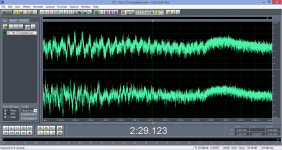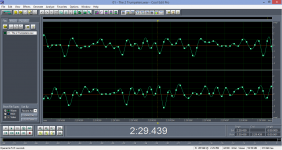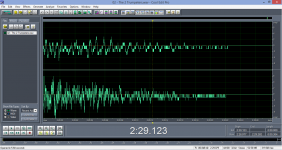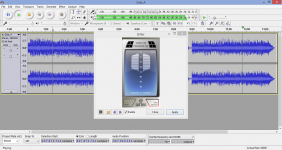no doubt JC has said more since then
No, unfortunately not much. That’s pretty much it.
P.S. Oooops... I believe Bybee Quantum Purifiers were not mentioned. What a loss for the posterity.
Last edited:
Dimitri, who sometimes contributes here, put my messages together for the 'Words of Wisdom' compilation.
It is hard to get a word in, edgewise, here, these recent years. I still make new and improved designs. It is just that my input would mostly be ignored and even worse, ridiculed by those who know less about audio design than I do.
Thanks, this is about 'capturing' the changes in system sound when Goop is applied, in this case a loopback interconnect cable which is less representative than a complete system but is a start nonetheless.Dan, I haven't followed your tests and I forgot what they were all about, but let me try.
The aim is that the electrical and sonic effects of other cables, dielectrics, tweaks, BQP etc can be recorded, discriminated and analysed, something I have yet to see in among all the historical/hysterical arguments of effects of cables and other items.
I have Audacity, Cool Edit, Audition and Reaper and yes this is what I have done.It all depends on what software you have available. If it's some kind of audio editor then just open the 16 bit file and then immediately save it as ('save as' command) 24 bit (WAV, AIFF, BWF etc) file.
Yes, that is my understanding and what I have been bashed for, 16bits is 16bits now matter what 'container' it is in, and any alteration including dithering is 'adding' information that was not there in the first case.If your software's code isn't broken (yes, it happens) then you will have your 16 bit data in a '24 bit 'container' so to speak with lower bits padded as zeros. Simple as that..
Yes I have done that and as far as I know the 24bit files originating as 16bit files are faithful copies, just in a differently scaled container.Also, check your software's preferences and make sure that dither, normalize or something similar is not set somewhere as option when exporting or saving..
Thank you, and you have helped already and explained and confirmed much more than the previous posts that just infer 'you're an idiot' in not so many words but do not give actual help and clarification.Feel free to ask any questions. I hope that I can help.
Agreed.[edit] Before conducting any experiments, one ought to test the tools used in that experiment. As someone once said: "Never turn your back to digital!" 😉
Ok, will do but it seems my method is correct but I may ask you for confirmation.[edit 2] If you can't handle the files by yourself, just point me to the originals and I'll do it for you. I have all sorts of tools available.
Thanks, Dan.
Dan, I will make my last attempt to get a meaningful information from yourself, about the files.
I am speaking about the files you linked yesterday. The two files I speak about are:
01 - The 2 Trumpeters.wav (I will call it "01")
and
02 - The 2 Trumpeters.wav (I will call it "02")
extracted from
Two Trumpeters.zip
Can you tell which is the original - 01 or 02?
01 is a 24bit coded file with 24bit LSB resolution. It can be seen when the music fades into noise. The noise might be the noise of your audio chain or the noise from the recording.
02 is a 24bit coded file with only 16bit LSB resolution. And, it has no dither. Again this can be told from the music fading into noise at the end of the sample.
My questions:
1) is 01 or 02 an original?
2) why 02 16bit file is not dithered?
3) do you realize that it is impossible to compare a true 24bit file with the 16bit undithered file? The difference goes for a different format, not the audio chain differences.
Plots attached again to show 24 x 16 bit undithered file 01 x 02.
P.S.: As a reminder, I can tell the difference in a foobar ABX with 100% success and I have posted the protocol. However, the audible difference goes for a format difference.
I am speaking about the files you linked yesterday. The two files I speak about are:
01 - The 2 Trumpeters.wav (I will call it "01")
and
02 - The 2 Trumpeters.wav (I will call it "02")
extracted from
Two Trumpeters.zip
Can you tell which is the original - 01 or 02?
01 is a 24bit coded file with 24bit LSB resolution. It can be seen when the music fades into noise. The noise might be the noise of your audio chain or the noise from the recording.
02 is a 24bit coded file with only 16bit LSB resolution. And, it has no dither. Again this can be told from the music fading into noise at the end of the sample.
My questions:
1) is 01 or 02 an original?
2) why 02 16bit file is not dithered?
3) do you realize that it is impossible to compare a true 24bit file with the 16bit undithered file? The difference goes for a different format, not the audio chain differences.
Plots attached again to show 24 x 16 bit undithered file 01 x 02.
P.S.: As a reminder, I can tell the difference in a foobar ABX with 100% success and I have posted the protocol. However, the audible difference goes for a format difference.
Attachments
Last edited:
Well, if you are dealing with some external box, you also have to make sure that it does not screw thing up. Check its driver and also System settings. Make sure it passes required number of bits.Thanks, this is about 'capturing' the changes in system sound when Goop is applied, in this case a loopback interconnect cable which is less representative than a complete system but is a start nonetheless.
If you know how to use plug-ins with any of these, let me point you to two useful and free (!) 🙂 tools for checking digital audio for some possible problems. First one is 'biscope': Bitter << Stillwell Audio and the other one is analyzer which goes down even below 24 bits Free Spectrum Analyzer Plugin, FFT, Real-Time [VST, AU, AAX] - SPAN | Voxengo All the technical details are on the product pages.I have Audacity, Cool Edit, Audition and Reaper and yes this is what I have done.
I'd suggest you start testing your setup for possible 'behind the scenes' truncation or gain manipulation. You will probably need some dithered 24 bit test tone for that.
Best,
Last edited:
3) do you realize that it is impossible to compare a true 24bit file with the 16bit undithered file? The difference goes for a different format, not the audio chain differences.
I am sure he could; it is the goop that doesn’t let him.
Frankly, I do not know what the "goop" is.
No problem, you’ll live.
Does it even exist?
Does it really matter?
<snip>
Pavel, what exactly are you doing when you get those abx results?
I saw them a minute ago but can’t find them now.......the one with the percentages of error etc.....how do you read the results?
Not sure what you mean with "how do you read the results", but PMA uses the Foobar ABX plugin, and this plugin uses the sum of correct answers as test statistics and runs a exact binomial test (unfortunately the analysis method with the highest risk of getting false negatives) to calculate the cumulated probability to get this number of correct answers by random guessing (or even better results).
PMA is probably using an older version as the line "probability that you were guessing" is not correct, as it is only the probability to reach this result (or a better one, in the general case) by random guessing.
And no, it is not just semantics, the difference between these two assertions is fundamental.
First one is 'biscope':
Bitter << Stillwell Audio
Thank you, and it works as a VST plugin even with the Audacity, immediately showing the real file resolution, regardless coding.
Frankly, I do not know what the "goop" is.
I still hope he will post some pictures of the system, showing what gooped stuff looks like.
Without images and after all the "UD" as SJ would say I start to wonder if it even exists.
I wonder if some who are interested in audio are musicians, or frustrated musicians, and whether this sometimes influences their desire to design an audio chain which does more than faithfully reproduce the recording. I remember JC saying he is and perhaps it could be the case. Nelson Pass famously considers himself to be part of the entertainment industry. So it depends what you mean by advancement in audio, what about Bruno's latest offerings, and where are the advancements to be made?
I see music as another world and audio as the portal to it. Why anyone would assume otherwise is beyond me.
Perhaps I am naive, and all the better for it.
Last edited:
Looks like grey/green/yellow plasticene.I still hope he will post some pictures of the system, showing what gooped stuff looks like.
Without images and after all the "UD" as SJ would say I start to wonder if it even exists.
Last edited:
I can't argue with that 🙂I see music as another world and audio as the portal to it. Why anyone would assume otherwise is beyond me.
Let's make that portal as clear as possible, so we can see it all, warts and all and be content with that. If we consider the recording art, isn't that what we should do?
- Status
- Not open for further replies.
- Home
- Member Areas
- The Lounge
- John Curl's Blowtorch preamplifier part III




